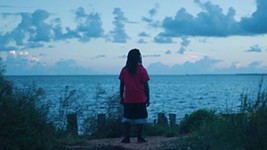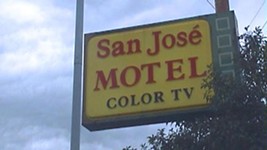Ask Questions First, Shoot Later
Texas Documentary Tour: Elizabeth Barret's 'Stranger With a Camera'
By Anne S. Lewis, Fri., Oct. 27, 2000

Elizabeth Barret's film Stranger With a Camera revisits a 33-year-old Letcher County, Kentucky, tragedy in which Appalachian landowner Hobart Ison killed documentary filmmaker Hugh O'Connor -- the stranger with a camera. O'Connor was working on a government-commissioned film about poverty in the Appalachian region and was shooting one of Ison's coal miner tenants on Ison's property, with the tenant's permission, when Ison got wind of it. He confronted the film crew with a gun, and as they hastily packed up to leave the property, Ison fired several shots, one killing O'Connor. In the end, an unrepentant Ison would serve one year of a 10-year sentence for manslaughter.
At the time of the murder, which made national news, Barret was a middle-class high school student growing up in a neighboring southeastern Kentucky town, preoccupied with such issues as her chances of becoming homecoming queen. But then she grew up to be a filmmaker and took a job at Appalshop, the regional media workshop in Whitesburg, in the same Kentucky county where the shooting took place. Then a "resident with a camera," whose mission working at Appalshop was to document Appalachian culture, Barret felt an inexorable need to take a second look at how a well-meaning stranger with a camera was murdered in her community in 1967 -- virtually without consequence.
With one foot in the "subject" camp and the other in the filmmaker's, Barret's narration takes us back to the Sixties, when the national media first discovered the impoverished Appalachian region and broadcast those now-familiar, Depression-esque images to the national consciousness. Stooped-over, soot-faced coal miners struggling to make ends meet on the pathetic wage paid by indifferent, rapacious strip-mining coal companies; hungry, illiterate, gap-toothed women and barefoot children staring hollow-eyed at the camera from their dilapidated front porches. Images like these galvanized the nation's response, unleashing the economic force of the War on Poverty.
While many in the region welcomed and were grateful for the good these images spurred on, others, including Hobart Ison, found them insulting and humiliating. (Barret herself recalls fearing at the time of the shooting that the rest of the country would think that everyone in Letcher Country was a hillbilly.) Many resented the onslaught of media trolling their streets in search of the perfect image of poverty. And in some quarters, there was considerable resentment of the do-gooders, the hippie VISTA volunteers who were deployed to the region to offer their "help" in taking on the evil coal companies.
Using the O'Connor shooting as a vehicle to understand the larger picture and to explore the complexities of the documentary subject's reaction and the filmmaker's obligation to them, Barret gives us an exhaustive look at both Ison's and O'Connor's stories. We hear from family members, community members, Ison's lawyer, O'Connor's colleagues, and Calvin Trillin reading aloud from the long New Yorker piece he wrote about the incident in 1969. Although at times, this evenhandedness feels like an exercise in "hate the sin; love the sinner," this was not Barret's intent. She was looking for an answer to a bigger question: What are the responsibilities of those who take images of others and put them to their own uses?
Barret admits that even though O'Connor's daughter, who was just a child when her father was murdered, had "reached a place of resolution," finally coming to understand that Ison was a "person of his times, culture, and place," Barret had reached no such point. She was still caught between her resident's instincts to protect her community from those who would harm it and her filmmaker's responsibility to see the community for what it is, telling its story no matter how difficult. In the end she concludes that all she can as do as a filmmaker is "to tell fairly what I see; to be true to the experiences of both parties and trust that that's enough."
Austin Chronicle: You started working at Appalshop in 1973, six years after the killing but only began work on Stranger With a Camera in 1992, finishing it eight years later. Before that, your films -- like Quilting Women, Coal Mining Women, Hand-Carved -- focused on the diversity of Appalachian customs, history, and craftsmanship. What was the process, for you, of finally deciding to make Stranger With a Camera?
Elizabeth Barret: The shooting took place in Letcher County, the same county that Appalshop is in. It's a story that's always been with us since beginning as trainees at the workshop learning filmmaking. When we went out into the community to make films, people would constantly remind us of what happened to Hugh O'Connor in this place. It was clear that people were reminding us of what had happened for a reason: It was held in community memory, and it had a lot of uses, one being a cautionary tale. I grew up in the county next to Letcher and was in high school when the killing happened so it had little meaning for me then. Then I read Calvin Trillin's article when I was in college, and that gave me a whole new perspective on this killing. And then the assistant cinematographer from O'Connor's crew came to town one day and talked to me about all of it. It just seemed that the more I made films, the more directly this story spoke to me.
AC: What were some of the challenges to getting this film made?
EB: Aside from the funding? It was initially very difficult to get people to sit down and be interviewed for this film. Locally, people felt like it was something they didn't really want a film made about. Why revisit it? Why dig it all up? They didn't want to be part of it. Hugh O'Connor's colleagues, on the other hand, were much more willing to be part of the project than the locals were.
It was also a challenge to put myself in the film. It turned out to be more difficult than I'd thought. It certainly made sense that my story be an integral part of it; I had a unique perspective as someone local who was now making films, but that didn't make it less challenging -- figuring out how to introduce myself as a character and integrate myself into the film, creating the voiceover.
AC:How would you articulate the film's conclusions about this incident?
EB: The film doesn't wrap things up neatly for the viewer. No easy answers are provided because there aren't any. The film is almost a question posed to the audience about media-making and the relationships of filmmakers to the people they're filming and the communities they're portraying. It recognizes that there are consequences to this kind of work. The film is a reflection of someone who's had her region portrayed and is fighting against those kinds of stereotypes.
The film also examines my own work [at Appalshop] where I'm telling stories from this community. It's sort of a meditation on my work over the years. It says there's a dynamic involved in making a documentary; there are tradeoffs. And there are not a lot of simple solutions. It's an ongoing challenge to be ethical, fair, to bring something back to the community and to think about the long-term effect of these images you're producing. So, during the War on Poverty, the media images were really weapons in this war on poverty: There was a purpose for those early black-and-white films; they were intended to rally public support for this huge federal effort. But there was another thing that people here suffered from: There was a history of stereotyping Appalachia. Not that these images weren't true or real, but that there are many lenses to look through within a community. And many times people felt these films were saying their poverty was a personal failure not a political one.
Hugh O'Connor paid a price for a whole history of image-making. He ended up being part of this whole confrontation and moment of violence where all these threads came together. The film tries to recognize the complexity and to look at all the layers and context that brought these two men together, one with a gun and one with a camera.
AC:What were your personal conclusions about the shooting?
EB: It should never have happened. Hugh never fathomed that he would encounter someone like Hobart. He was following all the rules. For myself, the context that it happened in is very important -- here you had someone who did this on purpose with no remorse. The tragedy of it is so compelling to me, both as a resident and as a filmmaker.
AC:So you weren't trying to make us feel sympathetic toward Ison?
EB: No, but I felt that the viewer had to learn about each of these character's lives. Ison's life said a lot about Appalachia -- how it went from a land economy to a cash economy ties together the historical, personal, and the political.
AC:Whatever happened to the film Hugh O'Connor was shooting the day he was killed?
EB: Hugh's film, US, was finished and shown as the centerpiece of the American Pavilion at Hemisfair in San Antonio in 1968. They used a few sections of the footage from Kentucky. Though it was commissioned by the Department of Commerce during LBJ's administration, the producer didn't want the film to be a puff piece about America, and the film was controversial. Apparently, Lady Bird didn't like it. She thought it should have been cheerier and that it reflected badly upon LBJ's administration.
AC:Tell us a little about Appalshop. At least two other filmmakers from there are now living in Austin -- Ann Lewis and Andy Garrison.
EB: Appalshop is in Whitesburg, Kentucky, a town of 1,200 people, in the southeastern corner of Kentucky, in the coal fields of the Appalachian mountains. The concept of Appalshop is to be a community-based media center; it's primarily local people documenting the history, culture, and social issues of their region. Part of its mission is to say, this is a diverse place with a very rich culture -- it's not solely defined by its economic indicators -- there's a culture and liveliness to the people there. The thinking is that there's a value to people from a place being empowered to produce their own images, stories, films, and TV.
The townspeople's reaction to Appalshop, since it opened in 1969, has been mixed. It was a War on Poverty effort, one of several film workshops set up around the country in areas of high youth unemployment. It started out as an Office of Economic Opportunity-funded project, called the Community Film Workshop of Appalachia. When that funding ended three years later, Appalshop incorporated on its own and now gets its own funding from a combination of state, federal, and private sources.
The original concept of training kids to do media work didn't make sense in this location because there were no media jobs to be had there. It made sense in urban places but not in Whitesburg. So the original concept was left behind, and Appalshop became a place where people from the area who had no training came to learn media-making and then stayed on. There are now 30 people working in film, video, and theatre -- and we've now got a new FM radio station. ![]()
Stranger With a Camera will be presented as part of the Texas Documentary Tour on Wednesday, November 1, 7:30pm & 9:30pm, at the Alamo Drafthouse, 409 Colorado. Filmmaker Elizabeth Barret will introduce the film and conduct a Q&A session following the screening. Advance tickets are available for Austin Film Society members only by calling 322-0145. Tickets will go on sale at 6:15pm on the day of the show. Admission prices are $6 per show for the general public; $4 for Austin Film Society and KLRU members and students. The Texas Documentary Tour is a co-presentation of the Austin Film Society, the University of Texas RTF Dept., The Austin Chronicle, KLRU-TV, and SXSW Film.








